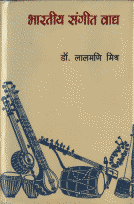Excerpts from
Bharatiya Sangeet Vadya -Swar-Mandal

|
Excerpts from Bharatiya Sangeet Vadya -Swar-Mandal |
 |
By Dr. lalmani Misra |

Similar to Shat-tantri Veena, Swar Mandal1 contains twenty one strings instead of a hundred. In his elucidation of Sangeet Ratnakar, Kallinath writes that Matt-kokila veena described by Shararangdev is none other than swar-mandal.2 There were some musicians in Akbar's court from Iran. One of them played the Qanoon. There is no fundamental difference between qanoon and swar-mandal. As per classical tradition swar-mandal employed twenty one and qanoon twenty eight strings. Qanoon was played with two small sticks (bent slightly in front) like santoor as well as with fingers like swar-mandal. Occasionally with a small piece of wood like the kramika of Ektantri-veena, they also tried to produce meend. All these practices were followed in swar-mandal also. In the description of swar-mandal Sangeet Parijaat and Sangeet Saar this statement is confirmed. Both, Sangeet Parijaat and Sangeet Saar describe it as pentagonal but the modern swar-mandal is quadrangular in shape. Though I have come across swar-mandal-s in several shapes and sizes, the difference arises more out of the maker's will than need. Normally its shape is a parallelogram with two ends closer than the other relatively wider ones. There are two main principles for tuning the strings -- one, the uppers strings are thinner than those used in lower notes and two, the length of strings in upper octaves is shorter than those in the lower ones. Swar-mandal uses both these principles. The strings from mandra saptak to madhya pancham get thinner to produce higher notes and strings from madhya pancham to ati-tar saptak produce higher notes because of their shorter length. From the point where the length of strings decreases, the body of swar-mandal may be trimmed down or given an aesthetic shape by an appealing cut.
A description of the shape of an average swar-mandal found today is given below:
Swar-mandal measures from two to two and half feet in length and one to one and quarter foot in width. The singer may choose to employ any number of strings from 21 to 36. The strings are hooked in the nail lodged in the right edge of swar-mandal and on the left, twirl around rectangular pegs which can be tightened with a special key. Wooden pegs were used in stead of metal ones in the medieval period. A sharp half-inch ridge is built on both sides of swar-mandal a little apart from the nails on which the strings are tightened. This ridge functions as bridge on both sides.
As already mentioned, half the strings in swar-mandal are of same length but some strings are thinner to give out higher pitch while the rest go on decreasing in length so that even with same thickness, the higher notes may be produced. As a result if length of the longest string is two feet the shortest string would measure just a foot.
Some makers put in a bead to facilitate fine-tuning without using the keys.
The contemporary swar-mandals come in various shapes but from a functional point of view they are same.
References :
1 "Sur-mandal, daf, jhanjh, taal, baajat madhyr mridang ||" Nanddas
"Sur-mandal, pinaak, mahuvari, jaltarang man mohe | " Krishnadas
2 "Mattkokilaiv loke swarmandalamityuchyate" Kallinath, Sangeet Ratnakar Teeka, p. 248

Links:
Excerpts from Bharatiya Sangeet Vadya - Sitar
Excerpts from Bharatiya Sangeet Vadya - Other Veena-s
Excerpts from Bharatiya Sangeet Vadya - Elements of Music
Dr. Lalmani Misra on Wikipedia
Bharatiya Sangeet Vadya 1973. Second edition, 2002. pp135-137
published by
Bharatiya Jnanpith
18, Institutional Area, Lodhi Rd
New Delhi - 110003